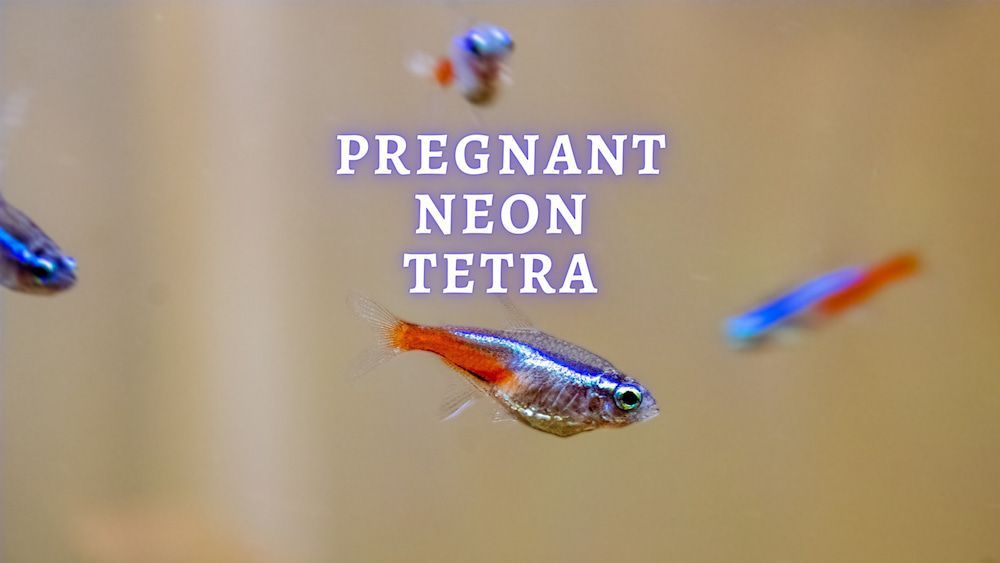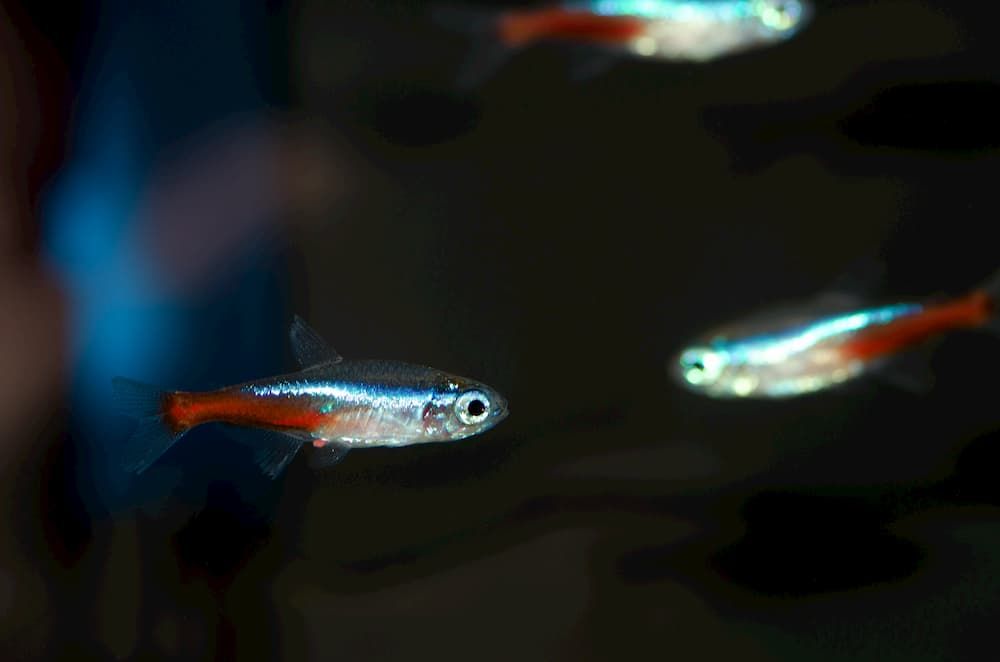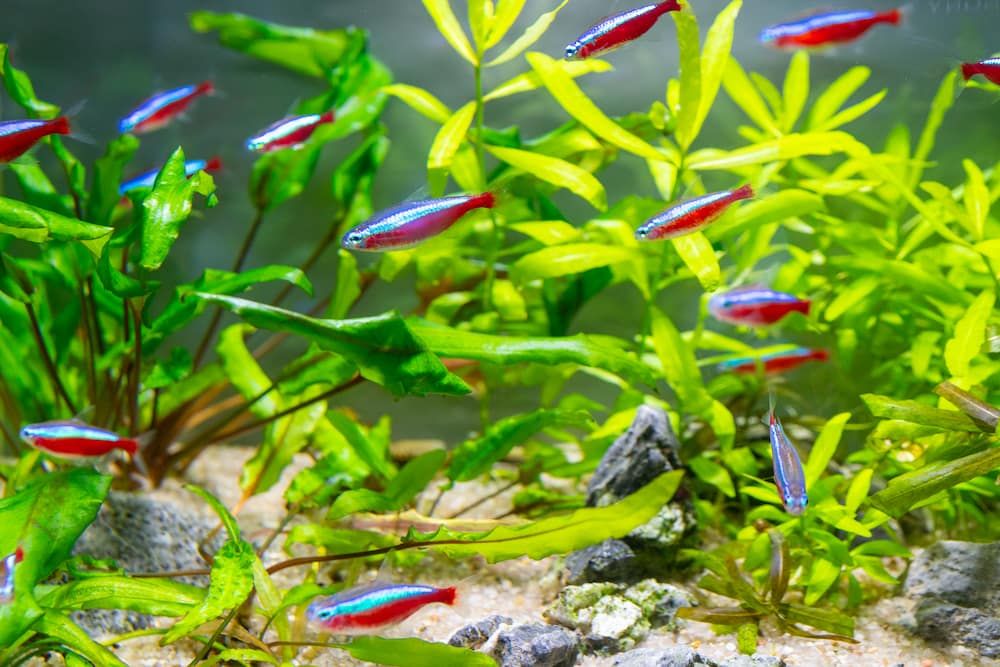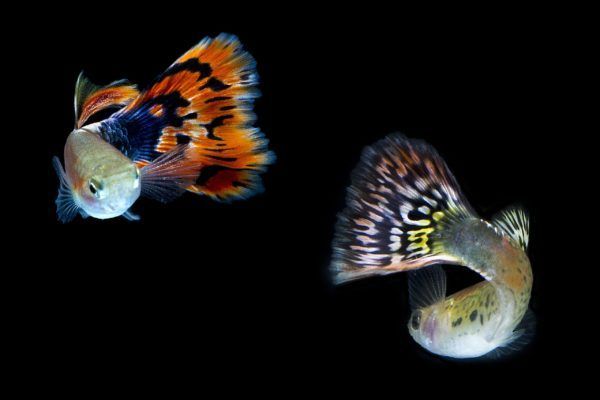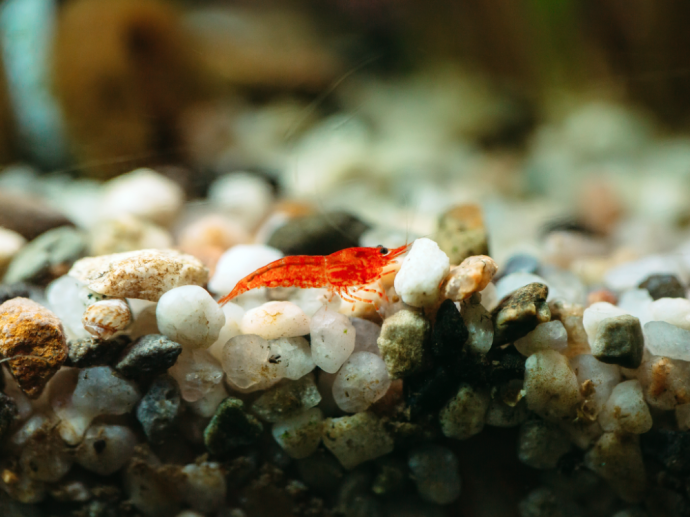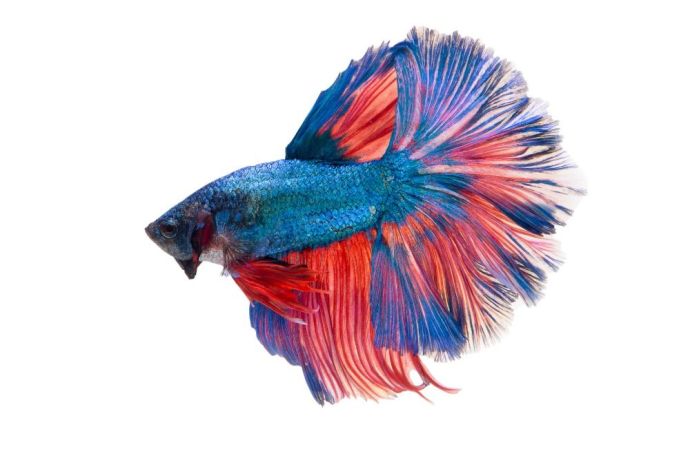Pregnant Neon Tetra: Everything You Need to Know About Neon Tetra Breeding
Written by:
Author: Vicki Smirnova
Vicki Smirnova is a professional writer and editor who adores animals and helps readers get along well with their pets. She has been working in digital media for more than 5 years and has great experience writing content about lifestyle, including pets. Vicki specializes in dog health and nutrition, cat feeding, dog training. She is an aquarium lover and is passionate to write about fish care at home. Also, Vicki headed several websites and worked as a news editor.
View all 244 articlesLearn about our editorial process and veterinary review board.
Viewed: 1208
Updated on: 02/08/2023
Neons belong to the haracin family and are one of the smallest aquarium fish, growing to about 1.5 inches. In nature, neons live in the reservoirs of South America, where they swim in large flocks, fleeing from predators. Neons, incredibly bright, colorful fish, have an elongated, laterally-flattened bodies. Coloring in different species can vary greatly; for example, neon blue and black. In aquariums, these fish live for about three years.
Along the body, all subspecies have characteristic stripes with a luminous color – a neon color effect – for which their owners love them so much. Neons are fish for aquarists who enjoy keeping flocks. Unlike their wild counterparts, who have a short life cycle, the domestic neon live for three years. Its small body is ideal for flocking in an aquarium.
History of neon tetra
In 1934, while exploring the jungles of Brazil, Auguste Rabaut discovered neon. Subsequently, he brought them to France, causing genuine interest from European aquarists. The following year, 1935, the most famous American aquarist of those days, William Innes, was brought several neons. He was so impressed with these fish that he gave them to his colleague, George Myers, the American Society of Ichthyologists president. In the summer of 1936, Myers presented a scientific description of neon. An interesting fact is that, for a long time, neon could not produce offspring in captivity. The problem was solved when it became clear that these fish needed soft water to breed.
How does neon tetra reproduce?
Neons live in South America, in the Amazon basin: in its left tributary, Putumayo, in Colombia and Peru, and in the right tributary, Puruse, in Brazil. Neons prefer quiet backwaters under the canopy of the rainforest, where they gather in large flocks, thereby effectively escaping predators.
In the wild, neon tetra spawning occurs during the rainy season and lasts 1.5-2 months during the year. When spawning ends, the fish calm down and take a break.
You will definitely need a separate spawning container to obtain neon offspring in an aquarium. In general, fish can spawn in the aquarium, but here the conditions rarely correspond to those needed for normal development. For example, water’s carbonate hardness for breeding neon should not exceed 4 °; otherwise, the shells of fish eggs become very dense, and the male spermatozoa cannot break through them and fertilize.
Neon females can lay eggs weekly, but after 5-6 spawnings, they should be given rest.
Before the planned spawning, neon males and females should be placed in different containers. The water temperature should be 71 ° F, and the fish should be heavily fed. Sometimes, before spawning, it is recommended to arrange short “dates” for the fish, placing future spawners together. Do this 2-5 times. Neons can only breed in water with a hardness of less than 4 dH.
While neons live in different places, care should be taken to prepare a spawning aquarium; any container with a volume of 2.5-6 gallons and a large bottom area will do. Before use, the aquarium should be thoroughly rinsed and disinfected; for example, with a weak solution of potassium permanganate. The soil in such an aquarium is unnecessary; instead, use bunches of Javanese moss, a separator mesh, or a nylon washcloth. When using live plants, it is essential to check them in advance for the presence of snails, which will quickly eat the eggs. Also, neons do not show concern for offspring; therefore, measures must be taken to ensure they do not eat their own eggs.
Next, shade the aquarium from all sides, as light is a threat to eggs and newborn neon tetra fry. Producers ready for spawning are best in the evening. It is most successful to use one female and a couple of males. Spawning itself takes place at dawn. Females randomly scatter eggs fertilized by the male and fall to the bottom, where they stick to plant leaves or spawning substrates. The fertility of one female can be up to 150 eggs. The eggs are transparent; it is not always possible to notice them the first time.
After spawning, the females are thinner and tired, and the color of the producers becomes pale. Male and female fish should be deposited with a disinfected net. After that, be sure to add an antifungal drug to the water – a large amount of caviar dies from infection with fungi in the first days of development. For the same reason, 9-12 hours after spawning, check the eggs for the presence of whitened eggs, which must be carefully removed with tweezers.
How to tell the difference between male and female neon tetras?
Unfortunately, adult fish sexual dimorphism is practically not visible at first sight. However, there are several signs to differentiate a male from a female. First, sexually mature fish differ in size: females are larger and have a more rounded abdomen, while males are very slender. Please pay attention to the bright stripe on the fish’s body: in males, it is even along the entire length; in females, it has a characteristic bend at the middle of the body. Also, during the breeding season, the swim bladder begins to stand out in males, shifting to the anus, which does not happen in females.
Sex differences:
| Female | Male |
| Convex abdomen | Elongated slender body |
| Modest color | Bright color |
| Larger body | Smaller body |
Aquarists speak positively about the neon fish, pleased with their simple care and beautiful appearance. But there are difficulties in reproduction because if all favorable conditions are not met, there will be no offspring.
Breeding requirements for neon tetras
Neon tetra fish can be bred at home, requiring specific skills. A couple (male and female) should be placed in a separate spawning aquarium, and the female spawns in moss or a special “net.”
RELATED: How To Set Up a Freshwater Fish Tank?
Breeding tank
Reproduction of neons in a typical aquarium is almost impossible: even with low water hardness, the eggs will not be fertilized. For the success of this process, separate small spawning tanks must be used. They make it easier to provide and maintain the conditions necessary for fertilization, incubation of eggs, neon tetra eggs hatching, and growth of juveniles. In addition, in the general aquarium, eggs will quickly become tasty and nutritious food for snails and bottom fish.
A filter cannot be installed in a spawning aquarium for breeding neon. Even the sponges of the weakest models attract microscopic fry, which will have no chance of survival. Aeration can be used, but the flow should not be very strong.
The water level in the spawning tank should be at most 4-6 inches. The water should be distilled with a small amount of available aquarium water. It should have the following parameters: T=77-78°F, pH=5.5-6.5, GH<4. It is advisable to add a preparation with a natural peat extract to the water, giving the water a characteristic “tea” shade, close to that in nature. Yellowish water also serves as a good light filter. Please note that the fish need acidic water, for which you can use the special Tetra pH/KH Minus.
Diet
Babies appear from the eggs on the 4th day, after another three days, the newborn fish begin to swim. They need to be fed with live micro feeds, e.g., brine shrimp nauplii or infusoria. Neon fry are very small, so a filter in the spawning is not used until they grow up.
Caring for a newborn fish
Usually, caviar ripens during the day. The main condition for a favorable outcome is maintaining the water temperature in the aquarium within 77-78°F.
Unfortunately, not all fertilized eggs will be able to survive – some may get sick with a fungus, and some will die during the ripening period. After nine hours, surviving, unspoiled, fertilized eggs can be separated from the rest with a medical pipette. Transfer them to another container with similar water parameters so that they do not become infected and die.
The hatched fish attach to the walls of the aquarium, and, for the first three days, they feed on the contents of their yolk sac. Approximately five days after birth, the cubs can begin to be accustomed to light.
Nurturing the fry
The neonatal period lasts approximately four weeks. A visual indicator of independent viability is the appearance of a stripe on the body.
Babies grow and develop well when fed with ciliates, rotifers or plankton. Most importantly, food must be of guaranteed quality and safe against bacteria.
Gradually, fry need to be accustomed to water of higher hardness. This is done by gradually adding water from the community aquarium to the water of the spawning tank.
As they grow older, neon fry should learn to independently search for food. Since they can primarily respond to light, they should be given food in a locally-lighted area. Then, the process of eating will not be stretched in time and food residues can be removed in a timely manner, preventing its undesirable decomposition.
As the fry acquire basic life skills, they can be transferred to the main aquarium, but it is advisable to keep them away from large, aggressive neighbors who can eat them.
Neon tetra breeding facts
- Breeding neon can be tricky, as it requires specific water parameters.
- A separate aquarium with soft water (1-2 dGH and pH 5.0 – 6.0) is needed for successful breeding.
- Cover the side walls with paper to reduce the amount of light entering the aquarium. The water temperature should be 77-78°F. As for plants, it is better to use mosses, on which the female will lay eggs.
- A couple should a large amount of live food; it is advisable to keep them separately for a week or two.
- When a couple is transplanted – which should be done at night, since spawning begins early in the morning – the aquarium should be completely dark. The male will chase the female, who will lay about a hundred eggs on the plants.
- It is possible, and even better, to use a nylon washcloth consisting of many tangled threads instead of plants.
- Immediately after spawning, the couple is replaced in another tank, so they won’t eat caviar.
- The larva from the eggs appears after 4-5 days, and after another three days, the fry begins to swim. To develop normally, they need to take a sip of air to fill the swim bladder, so make sure that there is no film on the water’s surface.
- Neon tetras eat small food – infusoria and egg yolk.
- It is important that there are no filters, as fry are very small and die in them.
- The most beautiful among the popular and unpretentious species are neon fish, the reproduction of which is more difficult than that of viviparous or angelfish.
- When transferring plants from a common body of water, be sure to carefully remove all snails. If there is no certainty that there are no mollusks in the grass, then it is best to use artificial protection for eggs: tangled fishing line, nylon nets or plastic washcloths. Soil in a spawning aquarium is not needed.
READ MORE: Betta Fish Tank Mates
People also ask
How can I tell if my neon tetra is pregnant?
Pregnant neon tetras tend to have enlarged or swollen bellies, because they carry a lot of eggs. Undoubtedly, this is the best indicator that a neon tetra is ready to spawn. After that, observer their courting behavior. Check the tank if the males are displaying any courting behavior.
How long are neon tetras pregnant for?
Usually fish spawn by the morning of the next day after jigging in a separate aquarium. However, this process may take up to three days.
Do neon tetras breed easily?
Reproduction of neon is a painstaking process that requires attention and experience. Everyone who would like to see invariably bright flocks of neon fish in their aquarium has to be convinced of this.
What do neon tetra eggs look like?
For the first few hours, the caviar is sticky with a yellowish tinge and can stick to the sheets. After a while, they sink to the bottom. Producers can be caught and released into a common aquarium. It is not recommended to leave them in a container with eggs, as at home neons can destroy their offspring.
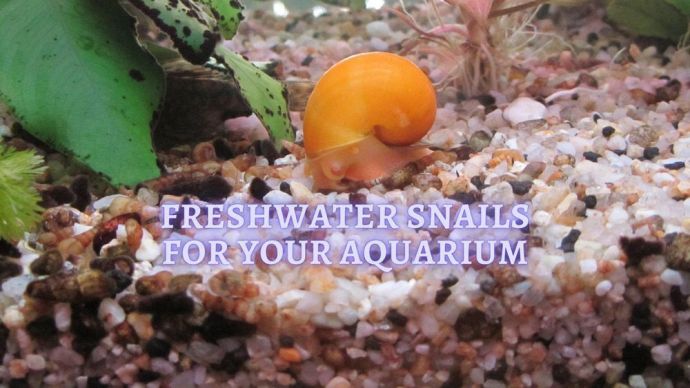 Fish Owners Tips Types of Freshwater Snails: Exotic cleaners for your Fish Tank
Fish Owners Tips Types of Freshwater Snails: Exotic cleaners for your Fish Tank - 1704
- 0









